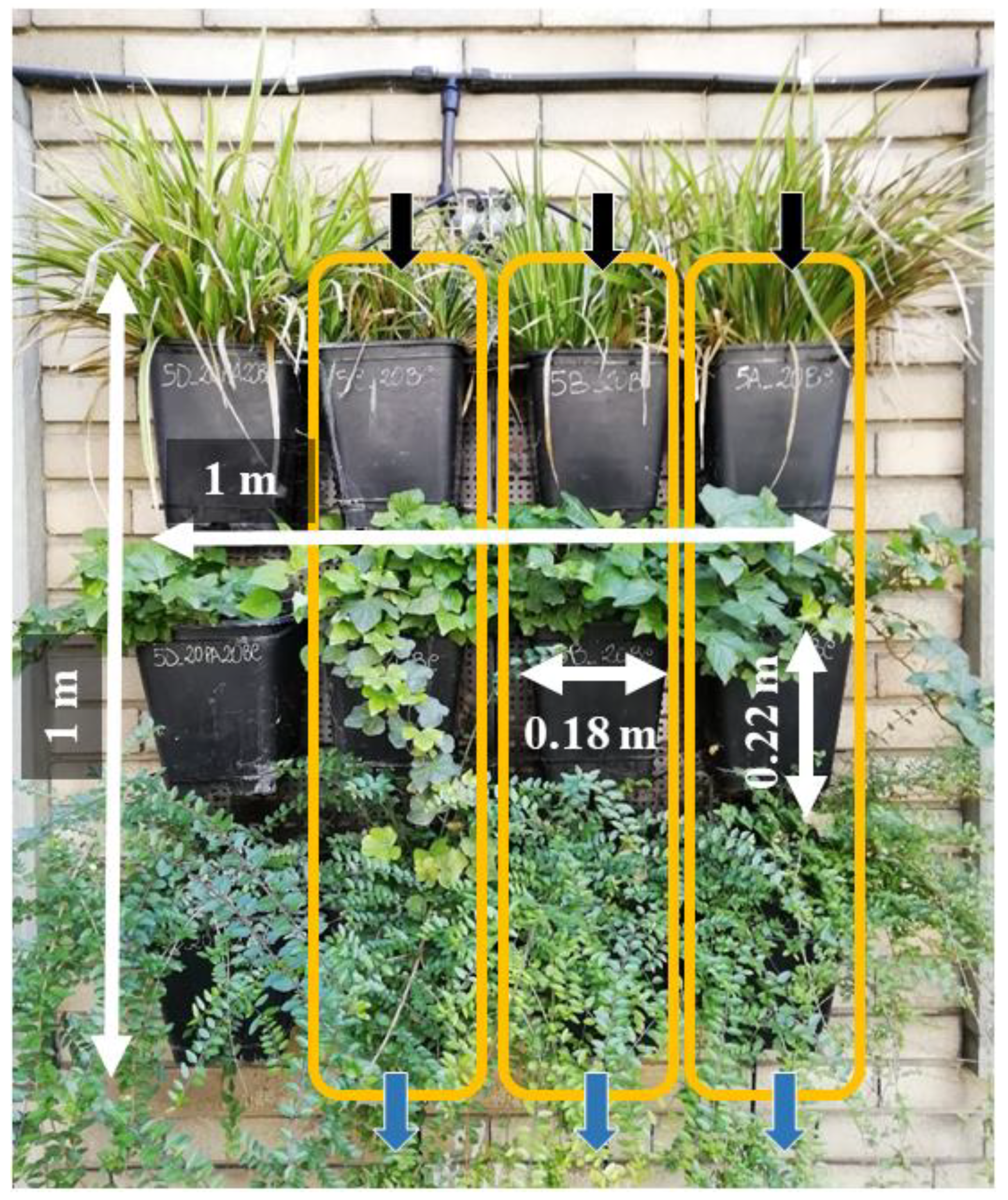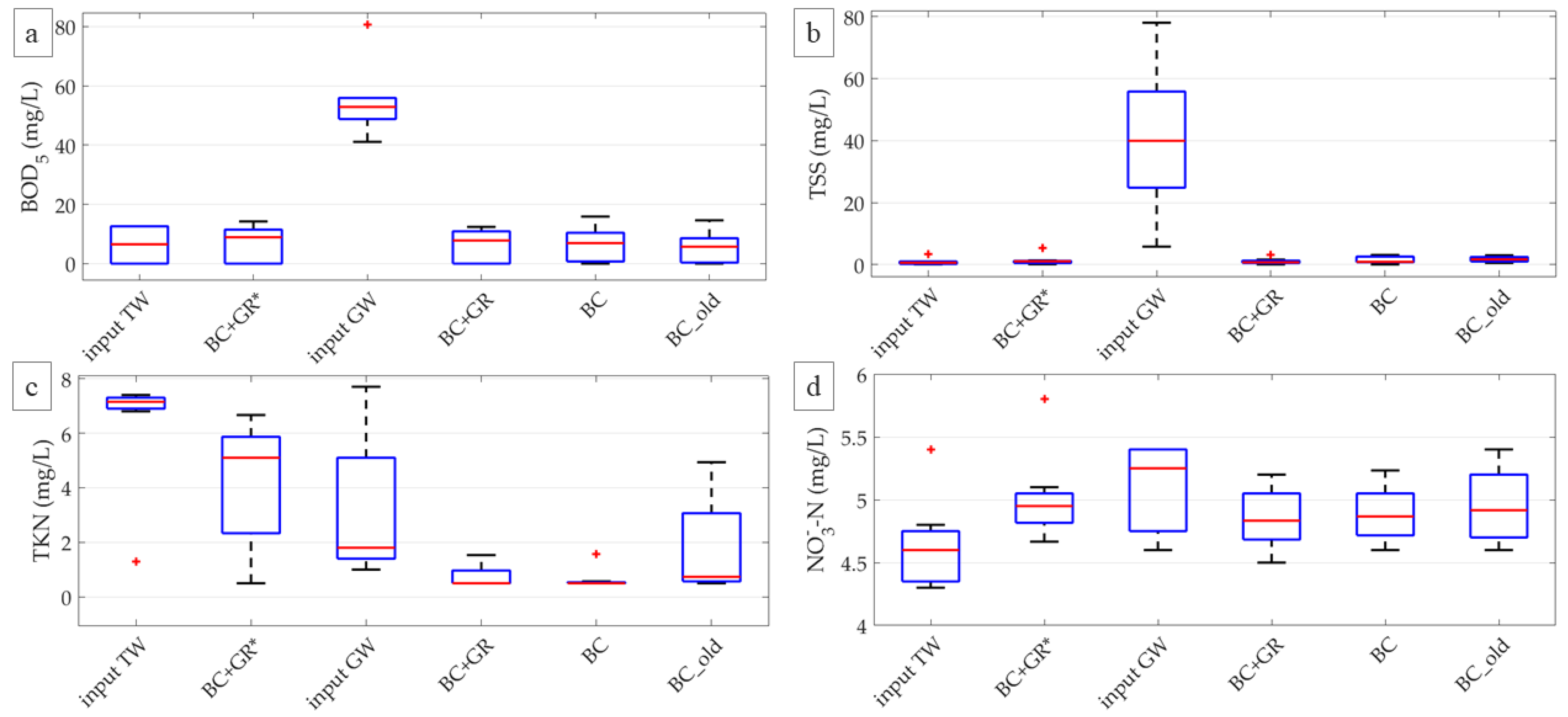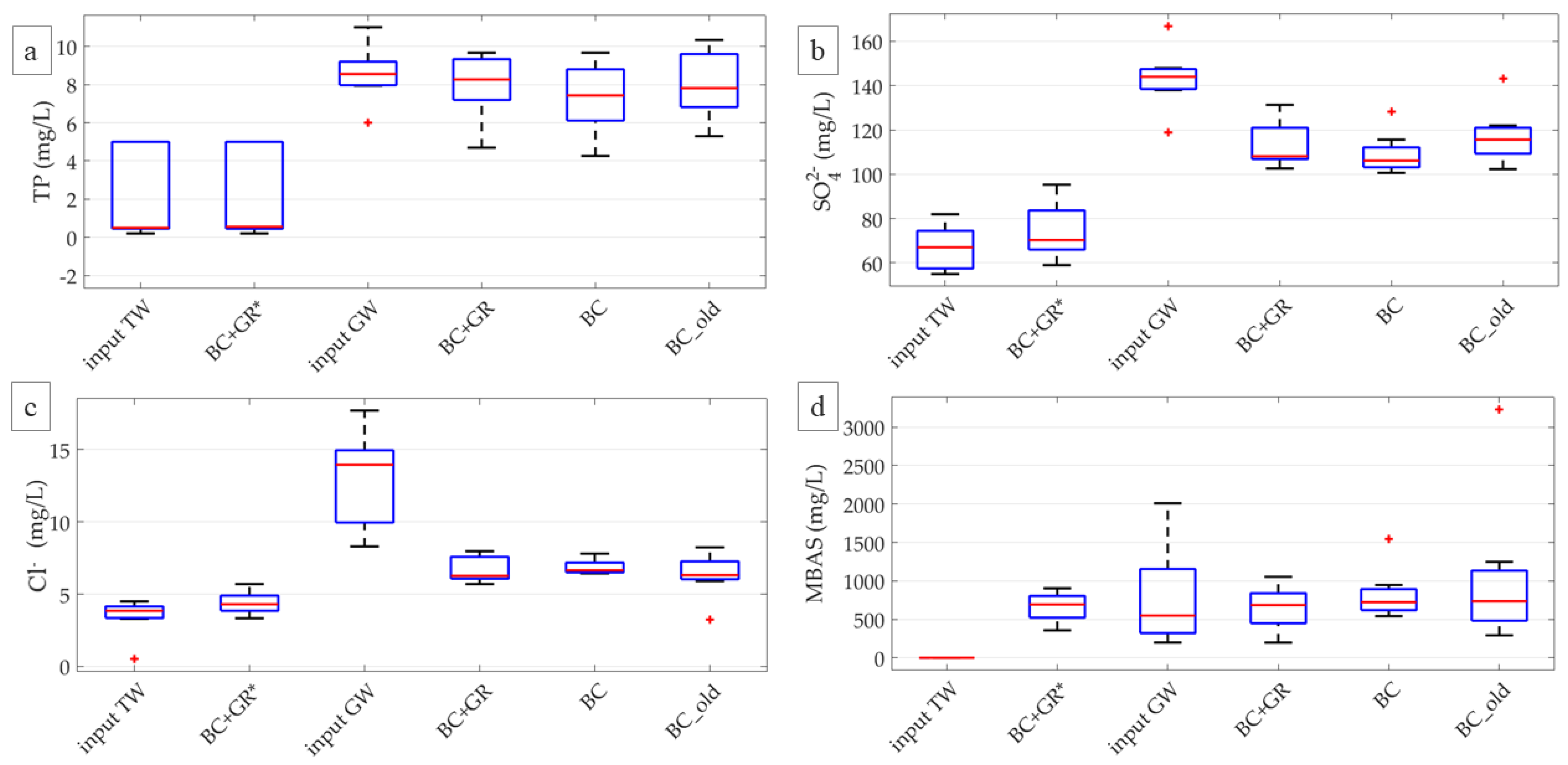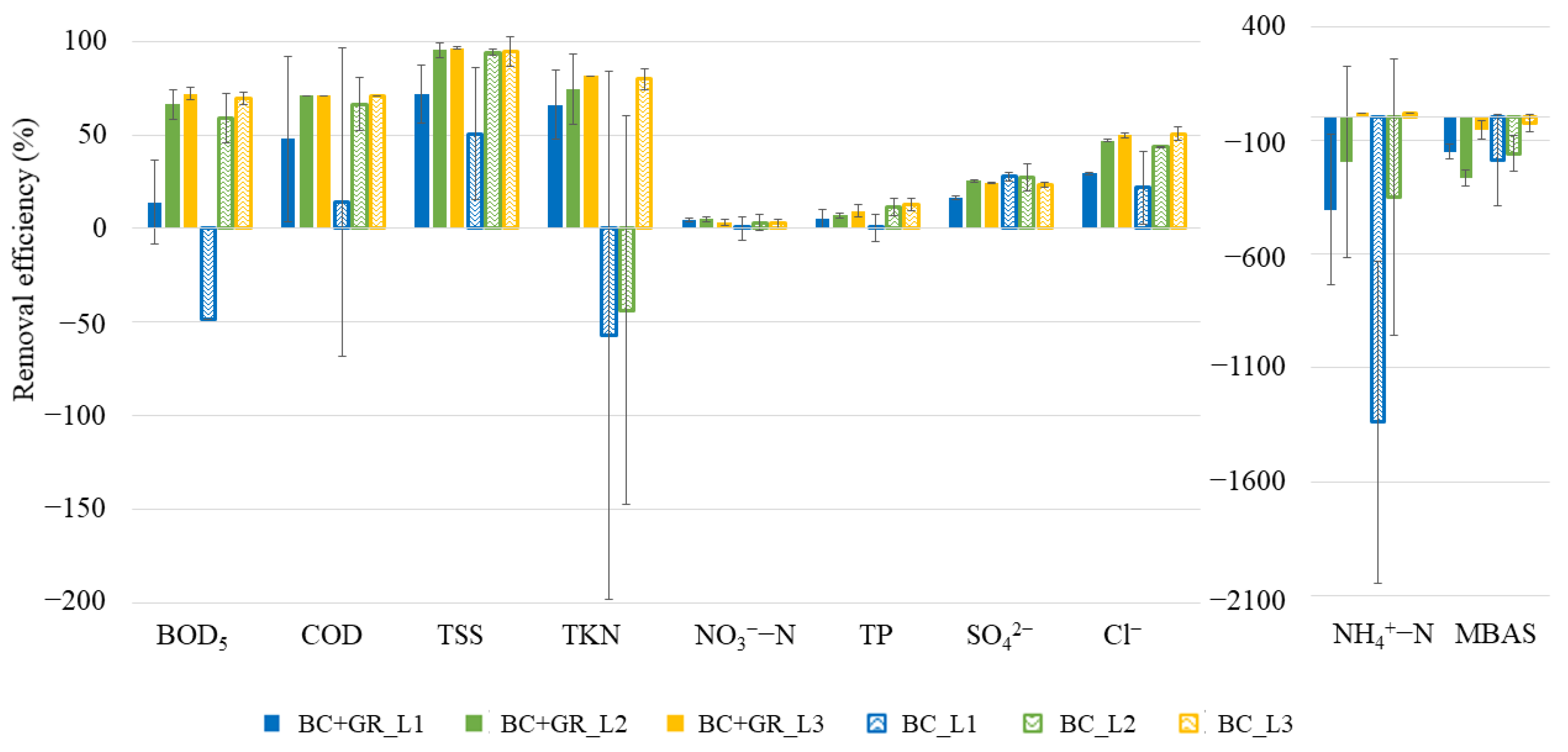Impact of Biochar and Graphene as Additives on the Treatment Performances of a Green Wall Fed with Greywater
Abstract
:1. Introduction
2. Materials and Methods
2.1. System Design and Operation
2.2. Sampling and Analytical Procedures
3. Results
3.1. Effect of System Age on Performance of Biochar Columns
3.2. Effect of Graphene Addition
3.2.1. Release from Graphene Columns
3.2.2. Effect of Graphene on GW-Fed Column Performance
3.3. Effect of Different Levels on Removal Efficiency
4. Discussion
5. Conclusions
Author Contributions
Funding
Data Availability Statement
Acknowledgments
Conflicts of Interest
References
- Boano, F.; Caruso, A.; Costamagna, E.; Ridolfi, L.; Fiore, S.; Demichelis, F.; Galvão, A.; Pisoeiro, J.; Rizzo, A.; Masi, F. A review of nature-based solutions for greywater treatment: Applications, hydraulic design, and environmental benefits. Sci. Total Environ. 2020, 711, 134731. [Google Scholar] [CrossRef] [PubMed]
- Priya, U.K.; Senthil, R. A review of the impact of the green landscape interventions on the urban microclimate of tropical areas. Build. Environ. 2021, 205, 108190. [Google Scholar] [CrossRef]
- Blanco, I.; Convertino, F.; Schettini, E.; Vox, G. Energy analysis of a green façade in summer: An experimental test in Mediterranean climate conditions. Energy Build. 2021, 245, 111076. [Google Scholar] [CrossRef]
- Cameron, R.W.F.; Taylor, J.E.; Emmett, M.R. What’s “cool” in the world of green façades? How plant choice influences the cooling properties of green walls. Build. Environ. 2014, 73, 198–207. [Google Scholar] [CrossRef] [Green Version]
- Castellar da Cunha, J.A.; Arias, C.A.; Carvalho, P.; Rysulova, M.; Canals, J.M.; Pérez, G.; Bosch, M.G.; Morató, J.F. “WETWALL”—An innovative design concept for the treatment of wastewater at an urban scale. Desalin. Water Treat. 2018, 109, 205–220. [Google Scholar] [CrossRef] [Green Version]
- Francis, R.A.; Lorimer, J. Urban reconciliation ecology: The potential of living roofs and walls. J. Environ. Manag. 2011, 92, 1429–1437. [Google Scholar] [CrossRef] [PubMed]
- Medl, A.; Stangl, R.; Florineth, F. Vertical greening systems—A review on recent technologies and research advancement. Build. Environ. 2017, 125, 227–239. [Google Scholar] [CrossRef]
- Pearlmutter, D.; Pucher, B.; Calheiros, C.S.C.; Hoffmann, K.A.; Aicher, A.; Pinho, P.; Stracqualursi, A.; Korolova, A.; Pobric, A.; Galvão, A.; et al. Closing water cycles in the built environment through nature-based solutions: The contribution of vertical greening systems and green roofs. Water 2021, 13, 2165. [Google Scholar] [CrossRef]
- Allen, L.; Christian-Smith, J.; Palaniappan, M. Overview of Greywater Reuse: The Potential of Greywater Systems to Aid Sustainable Water Management; Pacific Institute: Cedar Rapids, IA, USA, 2010; ISBN 9781893790292. [Google Scholar]
- Arden, S.; Ma, X. Constructed wetlands for greywater recycle and reuse: A review. Sci. Total Environ. 2018, 630, 587–599. [Google Scholar] [CrossRef]
- Maimon, A.; Gross, A. Greywater: Limitations and perspective. Curr. Opin. Environ. Sci. Health 2018, 2, 1–6. [Google Scholar] [CrossRef]
- Capodaglio, A.G. Taking the water out of “wastewater”: An ineluctable oxymoron for urban water cycle sustainability. Water Environ. Res. 2020, 92, 2030–2040. [Google Scholar] [CrossRef] [PubMed]
- Prodanovic, V.; Hatt, B.; McCarthy, D.; Zhang, K.; Deletic, A. Green walls for greywater reuse: Understanding the role of media on pollutant removal. Ecol. Eng. 2017, 102, 625–635. [Google Scholar] [CrossRef]
- Boano, F.; Caruso, A.; Costamagna, E.; Fiore, S.; Demichelis, F.; Galvão, A.; Pisoeiro, J.; Rizzo, A.; Masi, F. Assessment of the Treatment Performance of an Open-Air Green Wall Fed with Graywater under Winter Conditions. ACS EST Water 2021, 1, 595–602. [Google Scholar] [CrossRef]
- Pradhan, S.; Helal, M.I.; Al-Ghamdi, S.G.; Mackey, H.R. Performance evaluation of various individual and mixed media for greywater treatment in vertical nature-based systems. Chemosphere 2020, 245, 125564. [Google Scholar] [CrossRef] [PubMed]
- Masi, F.; Rizzo, A.; Bresciani, R.; Edathoot, A.; Patwardhan, N.; Panse, D. Greywater Treatment and Reuse in a Municipal Office in Pune by Vertical Gardens. Sustain. Sanit. Pract. 2016, 25, 28–33. [Google Scholar]
- Fowdar, H.S.; Hatt, B.E.; Breen, P.; Cook, P.L.M.; Deletic, A. Designing living walls for greywater treatment. Water Res. 2017, 110, 218–232. [Google Scholar] [CrossRef]
- Masi, F.; Bresciani, R.; Rizzo, A.; Edathoot, A.; Patwardhan, N.; Panse, D.; Langergraber, G. Green walls for greywater treatment and recycling in dense urban areas: A case-study in Pune. J. Water Sanit. Hyg. Dev. 2016, 6, 342–347. [Google Scholar] [CrossRef] [Green Version]
- Boano, F.; Costamagna, E.; Caruso, A.; Fiore, S.; Chiappero, M.; Pisoeiro, J.; Rizzo, A.; Masi, F.; Galv, A. Evaluation of the influence of filter medium composition on treatment performances in an open-air green wall fed with greywater. J. Environ. Manag. 2021, 300, 113646. [Google Scholar] [CrossRef]
- Wang, N.; Zhang, Y.; Zhu, F.; Li, J.; Liu, S.; Na, P. Adsorption of soluble oil from water to graphene. Environ. Sci. Pollut. Res. 2014, 21, 6495–6505. [Google Scholar] [CrossRef]
- Nidheesh, P.V. Graphene-based materials supported advanced oxidation processes for water and wastewater treatment: A review. Environ. Sci. Pollut. Res. 2017, 24, 27047–27069. [Google Scholar] [CrossRef]
- Prodanovic, V.; Hatt, B.; Mccarthy, D.; Deletic, A. Green wall height and design optimisation for effective greywater pollution treatment and reuse. J. Environ. Manag. 2020, 261, 110173. [Google Scholar] [CrossRef] [PubMed]
- Kotsia, D.; Deligianni, A.; Fyllas, N.M.; Stasinakis, A.S.; Fountoulakis, M.S. Converting treatment wetlands into “treatment gardens”: Use of ornamental plants for greywater treatment. Sci. Total Environ. 2020, 744, 140889. [Google Scholar] [CrossRef] [PubMed]
- Pérez, G.; Rincón, L.; Vila, A.; González, J.M.; Cabeza, L.F. Behaviour of green facades in Mediterranean Continental climate. Energy Convers. Manag. 2011, 52, 1861–1867. [Google Scholar] [CrossRef]
- Rysulova, M.; Kaposztasova, D.; Vranayova, Z. Green Walls as an Approach in Grey Water Treatment. In IOP Conference Series: Materials Science and Engineering; IOP Publishing: Bristol, UK, 2017; p. 072049. [Google Scholar]
- Serra, V.; Bianco, L.; Candelari, E.; Giordano, R.; Montacchini, E.; Tedesco, S.; Larcher, F.; Schiavi, A. A novel vertical greenery module system for building envelopes: The results and outcomes of a multidisciplinary research project. Energy Build. 2017, 146, 333–352. [Google Scholar] [CrossRef]
- Diaper, C.; Toifl, M.; Storey, M.V. Greywater Technology Testing Protocol. In CSIRO: Water for a Healthy Country National Research Flagship; CSIRO Australia: Canberra, Australia, 2008. [Google Scholar]
- Benjamini, Y.; Hochberg, Y. Controlling the false discovery rate: A practical and powerful approach to multiple testing. J. R. Stat. Soc. Ser. B 1995, 57, 289–300. [Google Scholar] [CrossRef]
- Pucher, B.; Zluwa, I.; Spörl, P.; Pitha, U.; Langergraber, G. Evaluation of the multifunctionality of a vertical greening system using different irrigation strategies on cooling, plant development and greywater use. Sci. Total Environ. 2022, 849, 157842. [Google Scholar] [CrossRef]
- Gattringer, H.; Claret, A.; Radtke, M.; Kisser, J.; Zraunig, A.; Rodriguez-Roda, I.; Buttiglieri, G. Novel vertical ecosystem for sustainable water treatment and reuse in tourist resorts. Int. J. Sustain. Dev. Plan. 2016, 11, 263–274. [Google Scholar] [CrossRef] [Green Version]
- Bakheet, B.; Prodanovic, V.; Deletic, A.; McCarthy, D. Effective treatment of greywater via green wall biofiltration and electrochemical disinfection. Water Res. 2020, 185, 116228. [Google Scholar] [CrossRef]
- Dal Ferro, N.; De Mattia, C.; Gandini, M.A.; Maucieri, C.; Stevanato, P.; Squartini, A.; Borin, M. Green walls to treat kitchen greywater in urban areas: Performance from a pilot-scale experiment. Sci. Total Environ. 2021, 757, 144189. [Google Scholar] [CrossRef]
- Lakho, F.H.; Vergote, J.; Ihsan-Ul-Haq Khan, H.; Depuydt, V.; Depreeuw, T.; Van Hulle, S.W.H.; Rousseau, D.P.L. Total value wall: Full scale demonstration of a green wall for grey water treatment and recycling. J. Environ. Manag. 2021, 298, 113489. [Google Scholar] [CrossRef]
- Lakho, F.H.; Qureshi, A.; Novelli, L.D.D.; Depuydt, V.; Depreeuw, T.; Van Hulle, S.W.H.; Rousseau, D.P.L. Performance of a green wall (Total Value WallTM) at high greywater loading rates and Life Cycle Impact Assessment. Sci. Total Environ. 2022, 821, 153470. [Google Scholar] [CrossRef] [PubMed]
- Estelrich, M.; Vosse, J.; Comas, J.; Atanasova, N.; Costa, J.C.; Gattringer, H.; Buttiglieri, G. Feasibility of vertical ecosystem for sustainable water treatment and reuse in touristic resorts. J. Environ. Manag. 2021, 294, 112968. [Google Scholar] [CrossRef] [PubMed]
- Zraunig, A.; Estelrich, M.; Gattringer, H.; Kisser, J.; Langergraber, G.; Radtke, M.; Rodriguez-Roda, I.; Buttiglieri, G. Long term decentralized greywater treatment for water reuse purposes in a tourist facility by vertical ecosystem. Ecol. Eng. 2019, 138, 138–147. [Google Scholar] [CrossRef]
- Prodanovic, V.; McCarthy, D.; Hatt, B.; Deletic, A. Designing green walls for greywater treatment: The role of plants and operational factors on nutrient removal. Ecol. Eng. 2019, 130, 184–195. [Google Scholar] [CrossRef]
- Cecconet, D.; Callegari, A.; Hlavínek, P.; Capodaglio, A.G. Membrane bioreactors for sustainable, fit-for-purpose greywater treatment: A critical review. Clean Technol. Environ. Policy 2019, 21, 745–762. [Google Scholar] [CrossRef]





| Configuration | Input | Tested Mixture (ID) | Deployment Date |
|---|---|---|---|
| biochar | greywater | 64% coconut fibre + 16% perlite+ 20% biochar (BC_old) | January 2019 |
| greywater | 64% coconut fibre + 16% perlite + 20% biochar (BC) | April 2019 | |
| biochar + graphene | greywater | 61% coconut fibre + 15% perlite + 19% BC + 5% Graphene (BC + GR) | April 2019 |
| tap water | 61% coconut fibre + 15% perlite + 19% BC + 5% Graphene (BC + GR*) | April 2019 |
| Product | Brand | Amount (g) in 100 L |
|---|---|---|
| Bodycream | Leocrema | 1.50 |
| Toothpaste | Pasta del Capitano | 3.25 |
| Deodorant | Sauber and Prep | 1.00 |
| Handsoap | Dermomed | 72.00 |
| Laundry | Soft | 15.00 |
| Na2SO4 | analytical grade | 3.50 |
| NaHCO3 | analytical grade | 2.50 |
| Na2PO4 | analytical grade | 3.90 |
| Clay | bentonitic | 5.00 |
| Boric acid | analytical grade | 0.14 |
| Lactic acid | analytical grade | 2.80 |
| Does BC configuration perform significantly better than the others? (on removal efficiency) | ||||||||||
| BOD5 | COD | TSS | TKN | NO3−-N | NH4+-N | TP | SO42− | Cl− | MBAS | |
| BC_old | 0.973 | NaN | 0.243 | 0.094 | 0.092 | 0.048 * | 0.007 * | 0.003 * | 0.830 | 0.391 |
| BC + GR | 0.498 | NaN | 0.955 | 0.177 | 0.798 | NaN | 0.123 | 0.139 | 0.842 | 0.846 |
| Does BC_old configuration perform significantly better than the others? (on removal efficiency) | ||||||||||
| BOD5 | COD | TSS | TKN | NO3−-N | NH4+-N | TP | SO42− | Cl− | MBAS | |
| BC | 0.027 | NaN | 0.757 | 0.906 | 0.908 | 0.952 | 0.993 | 0.997 | 0.170 | 0.609 |
| BC + GR | 0.241 | NaN | 0.975 | 0.917 | 0.987 | 0.952 | 0.509 | 0.864 | 0.238 | 0.818 |
| Does BC + GR configuration perform significantly better than the others? (on removal efficiency) | ||||||||||
| BOD5 | COD | TSS | TKN | NO3−-N | NH4+-N | TP | SO42− | Cl− | MBAS | |
| BC | 0.502 | NaN | 0.045 * | 0.823 | 0.202 | NaN | 0.877 | 0.861 | 0.158 | 0.154 |
| BC_old | 0.759 | NaN | 0.025 * | 0.083 | 0.013 * | 0.048 * | 0.491 | 0.136 | 0.762 | 0.182 |
| Is the output concentration of BC + GR* significantly higher than input TW? (on concentrations) | ||||||||||
| BOD5 | COD | TSS | TKN | NO3−-N | NH4+-N | TP | SO42− | Cl− | MBAS | |
| 0.110 | NaN | 0.069 | 0.929 | 0.066 | 0.361 | 0.099 | 0.096 | 0.092 | 0.000 | |
| Parameters | ||||||||||||||
|---|---|---|---|---|---|---|---|---|---|---|---|---|---|---|
| Mix | pH | T | EC | DO | BOD5 | COD | TSS | TKN | NO3−-N | NH4+-N | TP | SO42− | Cl− | MBAS |
| BC | 0.711 | 0.108 | 1.000 | 0.108 | 0.452 | 1.000 | 0.266 | 0.454 | 1.000 | 1.000 | 0.711 | 0.711 | 0.019 | 0.368 |
| BC_old | 0.174 | 0.108 | 0.711 | 0.230 | 0.260 | 0.879 | 0.063 | 1.000 | 0.536 | 0.288 | 0.902 | 0.711 | 0.902 | 0.764 |
| BC + GR | 0.035 | 0.108 | 1.000 | 0.035 | 0.181 | 1.000 | 0.386 | 0.386 | 0.212 | 1.000 | 0.174 | 1.000 | 0.266 | 0.764 |
| BC + GR* | 0.711 | 0.035 | 0.386 | 0.063 | 1.000 | NaN | 0.707 | 0.063 | 0.454 | 1.000 | 0.592 | 0.174 | 0.711 | 1.000 |
Disclaimer/Publisher’s Note: The statements, opinions and data contained in all publications are solely those of the individual author(s) and contributor(s) and not of MDPI and/or the editor(s). MDPI and/or the editor(s) disclaim responsibility for any injury to people or property resulting from any ideas, methods, instructions or products referred to in the content. |
© 2023 by the authors. Licensee MDPI, Basel, Switzerland. This article is an open access article distributed under the terms and conditions of the Creative Commons Attribution (CC BY) license (https://creativecommons.org/licenses/by/4.0/).
Share and Cite
Costamagna, E.; Caruso, A.; Galvão, A.; Rizzo, A.; Masi, F.; Fiore, S.; Boano, F. Impact of Biochar and Graphene as Additives on the Treatment Performances of a Green Wall Fed with Greywater. Water 2023, 15, 195. https://doi.org/10.3390/w15010195
Costamagna E, Caruso A, Galvão A, Rizzo A, Masi F, Fiore S, Boano F. Impact of Biochar and Graphene as Additives on the Treatment Performances of a Green Wall Fed with Greywater. Water. 2023; 15(1):195. https://doi.org/10.3390/w15010195
Chicago/Turabian StyleCostamagna, Elisa, Alice Caruso, Ana Galvão, Anacleto Rizzo, Fabio Masi, Silvia Fiore, and Fulvio Boano. 2023. "Impact of Biochar and Graphene as Additives on the Treatment Performances of a Green Wall Fed with Greywater" Water 15, no. 1: 195. https://doi.org/10.3390/w15010195





